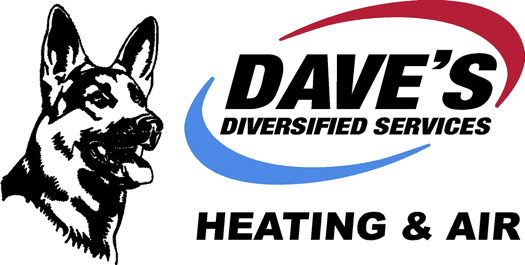
Ceiling fans are one of the most overlooked ways to make your home more comfortable and lower energy costs. By boosting air circulation and working in conjunction with your HVAC system, ceiling fans and energy efficiency are truly a match made in heaven. They offer a cost-effective, energy-efficient way to maintain your comfort in hot weather while easing strain on your AC—even preventing unnecessary air conditioning repair.
In this blog, the experts at Dave's Diversified Services break down how ceiling fans can improve your comfort while lowering your energy use with higher HVAC efficiency. We'll also offer some HVAC efficiency tips that put to good use ceiling fans.
Comfort vs. Temperature: The Effect of the Wind-Chill Effect Indoors
Ceiling fans don’t actually lower the room temperature—they make your home more comfortable by moving air over your skin. This is referred to as the wind-chill effect, and it can make a room feel up to 4 degrees cooler without touching the thermostat. That means you stay comfortable and enjoy the benefits of indoor air circulation from your ceiling fan while minimizing air conditioner use—helping reduce your electric bill in summer.
The Best of Both: Why You Should Use Fans and Air Conditioning Together
There are several advantages to using ceiling fans and air conditioning together, especially when it's very hot outside. By using both, you increase HVAC efficiency and maintain a comfortable indoor temperature with less strain from your cooling system.
Benefits of using ceiling fans and AC together:
- Ceiling fans help lower HVAC load by moving cool air more evenly around a room. Reducing HVAC stress is important, because it can save you from a breakdown that could result in premature AC or furnace installation.
- Using overhead fans boosts the comfort level of your home by getting rid of warm pockets and increasing airflow.
- Running both ceiling fans and AC can lower your utility usage. If you have a home automation system, you can even fine-tune your smart thermostat settings to increase the temperature slightly while your ceiling fan is running.
Clockwise vs. Counterclockwise Ceiling Fan Rotation: Which is the Correct Direction?
To make full use of your ceiling fans year-round, it’s important to make sure the blades rotate in the right direction for the season. The direction influences how air circulates, which can either or redistribute heat so you feel warmer.
When it's best to spin ceiling fans counterclockwise
On hot days, ceiling fans should turn counterclockwise at a faster setting. This creates a breeze that forces cool air down, increasing the wind-chill effect and causing you to feel cooler.
When to rotate ceiling fans clockwise
On cold days, set your fan to rotate clockwise on a low speed. This lifts cooler air and circulates heated air down to where you can feel it, making the space feel cozier without changing your thermostat.
How to Pick Out the Best Ceiling Fan for My Home
Choosing the right ceiling fan depends on a few key factors, including blade design, airflow rating and room dimensions. First, look for fans with a good blend of ECFM airflow and blade pitch to ensure efficient air movement in your space:
- ECFM refers to the amount of air a fan moves—the cubic feet per minute, or CFM—per watt of electricity used. Fans with greater ECFM are the most energy efficient.
- Blade pitch is the tilt of the blades. A steeper blade pitch moves more air than a shallower pitch but can also put extra load on the motor.
Also, consider room size when sizing a ceiling fan—a fan that’s too small won’t move enough air, while one that’s too large may be too strong for the space.
Boost Your HVAC Efficiency With Help from Dave's Diversified Services
At Dave's Diversified Services, our HVAC technicians can help you stay comfortable while reducing strain on your heating and cooling systems. From energy-saving ceiling fan tips and air conditioning installation to smart thermostats and furnace repair, we offer comprehensive services that work with your budget. Set up your appointment by calling 540-636-3396 today.
